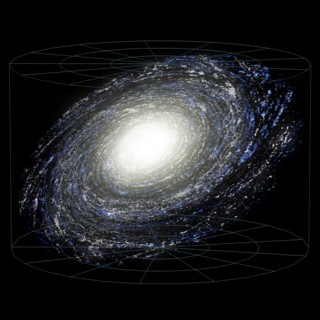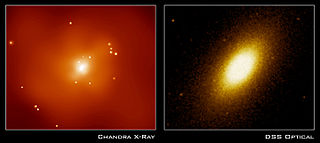Related Research Articles

The study of galaxy formation and evolution is concerned with the processes that formed a heterogeneous universe from a homogeneous beginning, the formation of the first galaxies, the way galaxies change over time, and the processes that have generated the variety of structures observed in nearby galaxies. Galaxy formation is hypothesized to occur from structure formation theories, as a result of tiny quantum fluctuations in the aftermath of the Big Bang. The simplest model in general agreement with observed phenomena is the Lambda-CDM model—that is, clustering and merging allows galaxies to accumulate mass, determining both their shape and structure. Hydrodynamics simulation, which simulates both baryons and dark matter, is widely used to study galaxy formation and evolution.

In astronomy, a galactic bulge is a tightly packed group of stars within a larger star formation. The term almost exclusively refers to the central group of stars found in most spiral galaxies. Bulges were historically thought to be elliptical galaxies that happened to have a disk of stars around them, but high-resolution images using the Hubble Space Telescope have revealed that many bulges lie at the heart of a spiral galaxy. It is now thought that there are at least two types of bulges: bulges that are like ellipticals and bulges that are like spiral galaxies.

Messier 53 is a globular cluster in the Coma Berenices constellation. It was discovered by Johann Elert Bode in 1775. M53 is one of the more outlying globular clusters, being about 60,000 light-years (18.4 kpc) light-years away from the Galactic Center, and almost the same distance from the Solar System. The cluster has a core radius (rc) of 2.18 pc, a half-light radius (rh) of 5.84 pc, and a tidal radius (rtr) of 239.9 pc.

The Monoceros Ring(monoceros: Greek for 'unicorn') is a long, complex, ring of stars that wraps around the Milky Way three times. This is proposed to consist of a stellar stream torn from the Canis Major Dwarf Galaxy by tidal forces as part of the process of merging with the Milky Way over a period of billions of years, although this view has long been disputed. The ring contains 100 million solar masses and is 200,000 light years long.

The Milky Way is the galaxy that includes the Solar System, with the name describing the galaxy's appearance from Earth: a hazy band of light seen in the night sky formed from stars that cannot be individually distinguished by the naked eye.
The Milky Way has several smaller galaxies gravitationally bound to it, as part of the Milky Way subgroup, which is part of the local galaxy cluster, the Local Group.

10 Tauri is a single star in the zodiac constellation of Taurus. It can be seen with the naked eye, having an apparent visual magnitude of 4.29. An annual parallax shift of 71.62 mas provides a distance estimate of 45.5 light years. It is moving further from the Sun with a radial velocity of +28 km/s and has a relatively high proper motion.

Galaxy mergers can occur when two galaxies collide. They are the most violent type of galaxy interaction. The gravitational interactions between galaxies and the friction between the gas and dust have major effects on the galaxies involved, but the exact effects of such mergers depend on a wide variety of parameters such as collision angles, speeds, and relative size/composition, and are currently an extremely active area of research. Galaxy mergers are important because the merger rate is a fundamental measurement of galaxy evolution and also provides astronomers with clues about how galaxies grew into their current forms over long stretches of time.

NGC 5986 is a globular cluster of stars in the southern constellation of Lupus, located at a distance of approximately 34 kilolight-years from the Sun. It was discovered by Scottish astronomer James Dunlop on May 10, 1826. John L. E. Dreyer described it as, "a remarkable object, a globular cluster, very bright, large, round, very gradually brighter middle, stars of 13th to 15th magnitude". Its prograde–retrograde orbit through the Milky Way galaxy is considered irregular and highly eccentric. It has a mean heliocentric radial velocity of +100 km/s. The galacto-centric distance is 17 kly (5.2 kpc), which puts it in the galaxy's inner halo.

NGC 2808 is a globular cluster in the constellation Carina. The cluster currently belongs to the Milky Way, although it was likely stolen from a dwarf galaxy that collided with the Milky Way. NGC 2808 is one of our home galaxy's most massive clusters, containing more than a million stars. It is estimated to be 12.5-billion years old.

In astronomy, stellar kinematics is the observational study or measurement of the kinematics or motions of stars through space.
The Pisces Overdensity is a clump of stars in the Milky Way's halo, which may be a disrupted dwarf spheroidal galaxy. It is situated in the Pisces constellation and was discovered in 2009 by analysis of distribution of RR Lyrae stars in the data obtained by the Sloan Digital Sky Survey's data. The galaxy is located at the distance of about 80 kpc from the Sun and moves towards it with a speed of about 75 km/s.

The thick disk is one of the structural components of about 2/3 of all disk galaxies, including the Milky Way. It was discovered first in external edge-on galaxies. Soon after, it was proposed as a distinct galactic structure in the Milky Way, different from the thin disk and the halo in the 1983 article by Gilmore & Reid. It is supposed to dominate the stellar number density between 1 and 5 kiloparsecs above the galactic plane and, in the solar neighborhood, is composed almost exclusively of older stars. Its stellar chemistry and stellar kinematics are also said to set it apart from the thin disk. Compared to the thin disk, thick disk stars typically have significantly lower levels of metals—that is, the abundance of elements other than hydrogen and helium.
In astronomy, the Sagittarius Stream is a long, complex structure made of stars that wrap around the Milky Way galaxy in an orbit that nearly crosses the galactic poles. It consists of tidally stripped stars from the Sagittarius Dwarf Elliptical Galaxy, resulting from the process of merging with the Milky Way over a period of billions of years.
Galaxy X is a postulated dark satellite dwarf galaxy of the Milky Way Galaxy. If it exists, it would be composed mostly of dark matter and interstellar gas with few stars. Its proposed location is some 90 kpc (290 kly) from the Sun, behind the disk of the Milky Way, and some 12 kpc (39 kly) in extent. Galactic coordinates would be (l= -27.4°,b=-1.08°).

NGC 720 is an elliptical galaxy located in the constellation Cetus. It is located at a distance of circa 80 million light years from Earth, which, given its apparent dimensions, means that NGC 720 is about 110,000 light years across. It was discovered by William Herschel on October 3, 1785. The galaxy is included in the Herschel 400 Catalogue. It lies about three and a half degrees south and slightly east from zeta Ceti.
References
- ↑ Kinman, T. D.; Wirtanen, C. A.; Janes, K. A. (July 1966). "An RR Lyrae Star Survey with the Lick 20-INCH Astrograph IV. a Survey of Three Fields Near the North Galactic Pole". The Astrophysical Journal Supplement Series. 13: 379. Bibcode:1966ApJS...13..379K. doi:10.1086/190140.
- ↑ Hartwick, F. D. A. (1987). "The structure of the Galactic halo". Proceedings of the NATO Advanced Study Institute. 207: 281–290. Bibcode:1987ASIC..207..281H.
- ↑ Newberg, Heidi Jo; Yanny, Brian (1 October 2006). "The Milky Way's stellar halo - lumpy or triaxial?". Journal of Physics: Conference Series. 47 (1): 195–204. arXiv: astro-ph/0507671 . Bibcode:2006JPhCS..47..195N. doi:10.1088/1742-6596/47/1/024. S2CID 250666026.
- ↑ Jurić, Mario; Ivezić, Željko; Brooks, Alyson (February 2008). "The Milky Way Tomography with SDSS. I. Stellar Number Density Distribution". The Astrophysical Journal. 673 (2): 864–914. arXiv: astro-ph/0510520 . Bibcode:2008ApJ...673..864J. doi:10.1086/523619. S2CID 11935446.
- ↑ Deason, A. J.; Belokurov, V.; Evans, N. W. (1 October 2011). "The Milky Way stellar halo out to 40 kpc: squashed, broken but smooth". Monthly Notices of the Royal Astronomical Society. 416 (4): 2903–2915. arXiv: 1104.3220 . Bibcode:2011MNRAS.416.2903D. doi: 10.1111/j.1365-2966.2011.19237.x . S2CID 119117899.
- ↑ Monachesi, Antonela; Bell, Eric F.; Radburn-Smith, David J.; Bailin, Jeremy (4 February 2016). "The GHOSTS survey – II. The diversity of halo colour and metallicity profiles of massive disc galaxies". Monthly Notices of the Royal Astronomical Society. 457 (2): 1419–1446. arXiv: 1507.06657 . Bibcode:2016MNRAS.457.1419M. doi: 10.1093/mnras/stv2987 .
- ↑ Trujillo, Ignacio; Bakos, Judit (2013-05-11). "Stellar haloes of disc galaxies at z ∼ 1". Monthly Notices of the Royal Astronomical Society. 431 (2): 1121–1135. arXiv: 1207.7023 . Bibcode:2013MNRAS.431.1121T. doi: 10.1093/mnras/stt232 . ISSN 0035-8711.
- ↑ Helmi, Amina (22 April 2008). "The stellar halo of the Galaxy". The Astronomy and Astrophysics Review. 15 (3): 145–188. arXiv: 0804.0019 . Bibcode:2008A&ARv..15..145H. doi:10.1007/s00159-008-0009-6. S2CID 2137586.
- ↑ Ibata, Rodrigo; Gibson, Brad (April 2007). "The Ghosts of Galaxies Past". Scientific American. 296 (4): 40–45. Bibcode:2007SciAm.296d..40I. doi:10.1038/scientificamerican0407-40. PMID 17479629.
- ↑ Gilbert, Karoline M.; Kalirai, Jason S.; Guhathakurta, Puragra; Beaton, Rachael L. (10 November 2014). "Global Properties of M31's Stellar Halo from the Splash Survey. Ii. Metallicity Profile". The Astrophysical Journal. 796 (2): 76. arXiv: 1409.3843 . Bibcode:2014ApJ...796...76G. doi:10.1088/0004-637X/796/2/76. S2CID 33355790.
- ↑ McCarthy, I. G.; Font, A. S.; Crain, R. A.; Deason, A. J. (1 March 2012). "Global structure and kinematics of stellar haloes in cosmological hydrodynamic simulations". Monthly Notices of the Royal Astronomical Society. 420 (3): 2245–2262. arXiv: 1111.1747 . Bibcode:2012MNRAS.420.2245M. doi: 10.1111/j.1365-2966.2011.20189.x . S2CID 53679383.
- ↑ Beers, Timothy C.; Carollo, Daniela; Ivezić, Željko; An, Deokkeun (10 February 2012). "The Case for the Dual Halo of the Milky Way". The Astrophysical Journal. 746 (1): 34. arXiv: 1104.2513 . Bibcode:2012ApJ...746...34B. doi:10.1088/0004-637X/746/1/34. S2CID 51354794.
- ↑ Schönrich, Ralph; Asplund, Martin; Casagrande, Luca (1 May 2014). "Does SEGUE/SDSS indicate a dual Galactic halo?". The Astrophysical Journal. 786 (1): 7. arXiv: 1403.0937 . Bibcode:2014ApJ...786....7S. doi:10.1088/0004-637X/786/1/7. S2CID 118357068.
- ↑ Cooper, A.P.; Cole, S.; Frenk, C.S. (1 August 2010). "Galactic stellar haloes in the CDM model". Monthly Notices of the Royal Astronomical Society. 406 (2): 744–766. arXiv: 0910.3211 . Bibcode:2010MNRAS.406..744C. doi: 10.1111/j.1365-2966.2010.16740.x . S2CID 43143695.